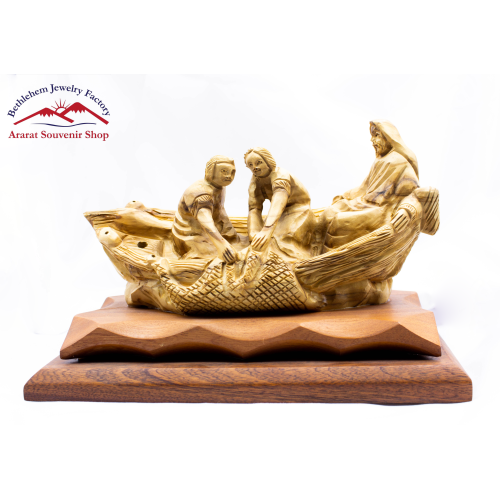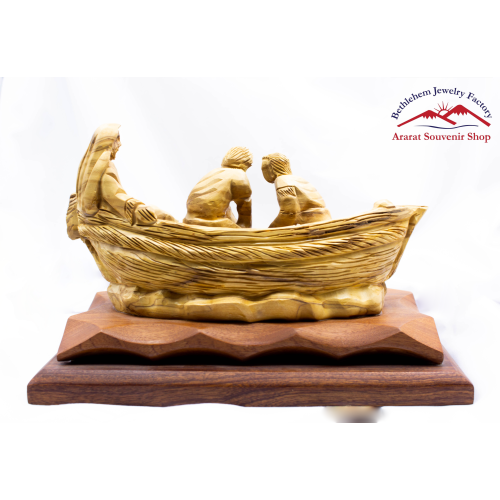Jesus and Disciples in the Boat
The image of Jesus and his disciples in a boat evokes a powerful narrative of faith, struggle, and divine intervention. This scene, most vividly depicted in the Gospels of Matthew, Mark, and Luke, captures a moment when Jesus, after a day of teaching, instructs his disciples to cross the Sea of Galilee to the other side. This journey, while seemingly straightforward, becomes a profound lesson about trust, fear, and the power of faith.
As the disciples set sail, the atmosphere shifts dramatically from calm to chaos. The Sea of Galilee, a relatively small freshwater lake, is known for its sudden storms due to its geography—surrounded by hills, the region can experience swift changes in weather. As the boat rocks violently amidst the rising waves and howling winds, the disciples, many of whom were seasoned fishermen, are seized by fear. Their experience at sea does little to quell their anxiety; instead, it highlights their vulnerability amidst nature’s fury.
In this moment of crisis, Jesus, who is asleep in the stern of the boat, embodies a profound contrast to the panic-stricken disciples. His restful state suggests a deep sense of peace and assurance, demonstrating his divine nature. The disciples’ desperation grows, leading them to awaken Jesus, pleading, “Teacher, do you not care that we are perishing?” (Mark 4:38, ESV). This cry reflects not just their fear of physical danger but also a deeper spiritual anxiety—a questioning of Jesus’ concern for their welfare.
The response of Jesus is striking and multi-layered. Rising from his rest, he addresses both the storm and the hearts of his disciples. With a commanding voice, he rebukes the wind, saying, “Peace! Be still!” (Mark 4:39, ESV). Immediately, the winds cease, and a great calm envelops the sea, symbolizing not only a physical stillness but also a restoration of order from chaos. The disciples, witnessing this miraculous act, are left in awe, questioning among themselves, “Who then is this, that even the wind and the sea obey him?” (Mark 4:41, ESV). This moment marks a crucial turning point in their understanding of Jesus’ identity, revealing him as both teacher and divine authority over nature.
This poignant episode serves multiple theological purposes. Firstly, it emphasizes the importance of faith in the midst of trials. While the disciples have witnessed various miracles performed by Jesus, they struggle to fully grasp his power and authority. Jesus’ question, “Why are you so afraid? Have you still no faith?” (Mark 4:40, ESV), highlights the ongoing challenge of cultivating trust in God, especially in moments of fear and uncertainty. The fear of the storm mirrors the fears individuals face in their daily lives—uncertainty, doubt, and anxiety are universal experiences, and the call to faith amid these trials resonates deeply.
Moreover, the narrative of Jesus and the disciples in the boat offers a profound reflection on community and shared experiences. The disciples’ collective fear reveals the human tendency to succumb to panic in troubling situations, echoing a shared vulnerability. Yet, within this turmoil, they also turn to Jesus together, illustrating that faith can often begin as a communal effort—a coming together in seeking help during crises. This interconnectedness is an essential theme in Christianity, emphasizing the importance of community support in nurturing faith.
The symbolism of the boat itself carries significant weight. It can be seen as a representation of the Church—an assembly of believers navigating the stormy seas of life. Just as the disciples were not alone in the boat, modern believers are called to support one another through challenges, trusting in Christ’s presence amidst the storms. This scene reassures Christians that they are not abandoned, even when Jesus’ presence may seem distant.
Throughout Christian art and literature, the scene of Jesus calming the storm has inspired countless interpretations. Artists, poets, and theologians have drawn upon this powerful image to convey themes of hope, salvation, and divine sovereignty. The calmness that follows the storm serves not only as a miracle but as a testament to the peace that faith provides in tumultuous times.
As this event resonates through the centuries, it invites believers to reflect on their own journeys of faith. The call to trust in Jesus during life’s storms becomes a central tenet of the Christian message. Thus, the story of Jesus and his disciples in the boat is not just an account of a miraculous event; it is an enduring narrative that speaks to the human condition—a testament to the transformative power of faith amid fear and uncertainty.
In conclusion, the experience of Jesus and his disciples in the boat encapsulates vital lessons about faith, community, and divine authority. It affirms the belief that even in our darkest moments, we are called to trust in a higher power, who possesses the ability to bring peace to our chaotic lives. As believers navigate their own storms, the story remains a source of inspiration and assurance, fostering a deeper understanding of both Jesus’ character and the collective faith that holds communities together.











Reviews
There are no reviews yet.